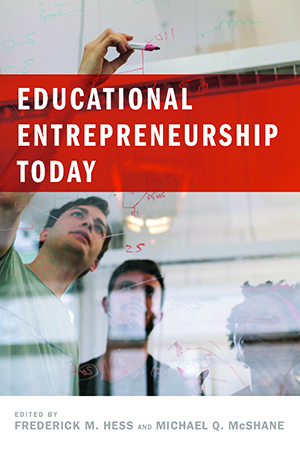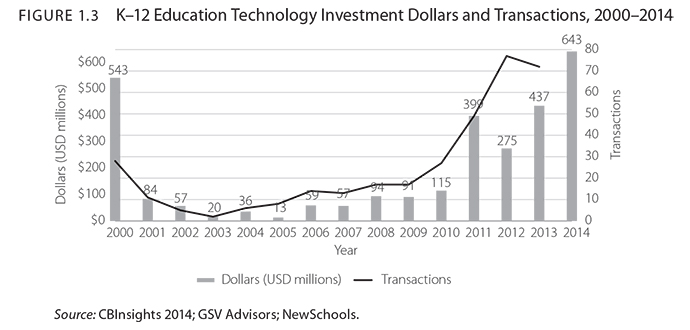In recent years, education entrepreneurs have been busy creating tools and services to support teachers and students in an effort to break into what is now a $19 billion market. The following excerpt from the chapter “From Generation to Generation: Fifteen Years of Education Entrepreneurship,” by Stacey Childress, Chief Executive Officer of NewSchools Venture Fund, takes a look at the market for new software, instructional materials, assessments, and data platforms being developed by entrepreneurs. This chapter appears in the volume Educational Entrepreneurship Today, edited by Frederick R. Hess and Michael Q. McShane.
 Developing and Scaling New Tools
Developing and Scaling New Tools
In addition to creating new schools and preparing higher-performing teachers and leaders, education entrepreneurs have pursued opportunities to develop better tools and services for students, teachers, and administrators. Just as the market for schools is deeply shaped by the political and regulatory environment at the city, state, and federal levels, so too is the market for instructional materials, assessments, and data platforms.
The combined spending for basal and supplemental materials, instructional software, assessment, and tech hardware segments is around $19 billion annually. Though this is a lot of money in absolute terms, it only accounts for around 3 percent of the total annual spending in K–12 public education. If these budgets were zeroed out—no future spending on servers, data systems, laptops or tablets, instructional software, digital and printed assessments, interactive whiteboards, textbooks or any book at all— and every penny was reallocated to other K–12 spending, there would be enough extra money to run the entire system for only six additional days in a 180-day school year. It’s an astonishingly small amount in light of the provocative headlines from the education press and bloggers about private interests in education and union leader talking points about the corporate takeover of public education.
Even so, entrepreneurs flocked to education technology between 2010 and 2014 following a market contraction in the previous decade, as displayed in figure 1.3. In 2009, there were seventeen investments in K–12 companies totaling approximately $91 million; in 2014 there were eighty-five, totaling $643 million. This represents a five-year compound annual growth rate of 48 percent, compared with 19 percent for total US venture capital.18 In 2014, K–12 ed tech investing surpassed the level of capital flows it had attracted in 2000, at the height of the Internet boom.
Five factors contributed to the growth from 2010 to 2014:
Broader technology trends. Throughout the 2000s, technology devices became cheaper and easier to use, concurrent with a general growth in web services and mobile applications. Even as systemic inequalities in social outcomes such as educational attainment and family income remained stable, sophisticated consumer technologies caught on and crossed socioeconomic boundaries.
Education industry dynamics. Th emarket for print and digital instructional materials and assessments totals approximately $10 billion. The market overall grew very slowly between 2009 and 2014, while the ed tech market boomed. There were also significant shifts in purchasing from print to digital resources, and from “basal” (mostly textbooks) to supplemental materials. In fact, at about 8 percent annual growth from 2011 to 2014, digital supplemental instructional materials were the fastest-growing segment in the industry.
High-profile “exits” that generated significant returns for entrepreneurs and investors. News Corp bought Wireless Generation (WGen) in 2010, and Pearson purchased Schoolnet in 2011.19 The companies sold for a premium, equal to between six and seven times revenue. Each had two things their acquirers wanted: (1) data collection, analysis, and reporting products and platforms that teachers and administrators used and liked, and (2) entrepreneurial, visionary leaders and talented product development teams.
These acquisitions had a profound effect on the imaginations of ed tech entrepreneurs. In 2007, WGen CEO Larry Berger coauthored “Slow Entry, Distant Exit,” an influential paper about how industry dynamics made it hard to build an ed tech company.20 But in November 2010, Berger and his cofounders were able to sell 90 percent of their company to News Corp at a $390 million valuation. Suddenly, it seemed possible to build a company focused on creating educational value and generate significant financial returns for the founders and investors.
New capital sources. In 2011, New Schools Venture Fund allocated $1million in unrestricted dollars to launch a seed fund to make equity investments in early stage ed tech companies. The Seed Fund eventually attracted capital from individual philanthropists and a few foundations, including Gates and Dell. Three years later, it had invested approximately $10 million in thirty-eight companies. Its companies have raised more than $160 million in additional capital and reached more than sixty million students. In the same time period, two new K–12 focused venture funds, Rethink and Owl Ventures, launched. Both invest in companies after the seed stage after some of the early risk has been reduced. A number of prominent venture capital firms also began investing during this period, including KleinerPerkins Caulfield & Byers, Bessemer Venture Partners, Accel Partners, and Google Ventures.
Government actions. Between 2000 and 2009, NCLB, Reading First, and the State Longitudinal Data Systems initiative sparked activity in segments such as tutoring services, early grade reading materials, and data storage and management. From late 2009 through 2014, additional state and federal initiatives created opportunities and challenges for entrepreneurs:
• The widespread adoption of Common Core State Standards (more than forty states) created more of a national market for math and reading content, in contrast to the fifty individual state markets that existed previously. Mass adoption of CCSS also created a “moment in time” in which school and district leaders in the adopting states were looking for new content and assessments in line with the new standards.
• Race to the Top’s awards for Instructional Improvement Systems (IIS), totaling around $500 million, required state education departments to create statewide systems for delivering content and assessments and collecting and reporting performance data. Because this initiative happened concurrently with CCSS, it created new demand in many states for platforms that could manage content, assess- ments, and data to personalize learning for students.
• State and federal programs like CCSS, RTTT, and the Partnership for Assessment of Readiness for College and Careers and Smarter Balanced Assessment Consortia (groups of states who had adopted CCSS and agreed to work together on developing aligned, shared assessments) slowed down the market for content, assessments, and platforms in some ways. They extended already long sales cycles for state and district data and assessment platforms by at least two years while buyers tried to figure out the implications of CCSS and the assessment consortia on the architecture and functionality of their statewide IIS platforms. And once states accepted tens of millions of federal dollars for things they had always funded themselves, federal compliance rules came into play. This exacerbated the inherent risk-aversion and “box-checking” request for proposal processes in state education offices and school districts by adding federal sanctions to the list of risks they already faced in their procurement processes. As a result, few entrepreneurial companies secured business through these mechanisms; rather, the largest entrenched companies such as Pearson, secured large contracts from multiple states and the assessment consortia.
Though these factors created a mix of positive and negative incentives, on balance they added up to new opportunities for entrepreneurs. Between 2010 and 2014, investors poured money into companies that developed product and business model innovations in response to the market dynamics. Below are just three examples of the many types of innovation that took place in that timeframe:
“Users before institutions” business models. In an effort to reach teachers and students directly and avoid complicated procurement processes for as long as possible, a number of entrepreneurs pursued new approaches to sales and distribution. One version is bottom-up—targeting individual teachers who adopt the product, which then often spreads to groups of their fellow teachers and sometimes schoolwide with the goal being full district adoption. These are usually “freemium” models where teachers pay nothing for basic access and a small amount for additional features such as classroom dashboards and reports; school- or district-wide packages come with a licensing fee. Growing companies that have taken this approach include Newsela, eSpark, LightSail, DreamBox, and ST Math.
Another version of this business model generates revenue from other partners in order to keep the product free to schools and districts. Examples of companies who grew with this approach are Clever, a data integration solution, and Edmodo, a classroom management platform; both charged vendors for access to their products so that teachers, schools, and districts could use them at no charge. (Edmodo has recently switched to more of a freemium model.) And of course, nonprofit Khan Academy is free to its twelve million monthly users, but generates revenue from corporate partnerships and philanthropy.
Teachers as creators and decision makers. On the premise that no one knows teaching like teachers, some entrepreneurs have developed products around the instructional expertise of teachers. LearnZillion uses “Dream Team” teachers every year to create CCSS-aligned video lessons available to teachers everywhere. Nearpod gives every teacher the tools to create and share les- sons with students and other teachers. Teachers Pay Teachers is a platform through which teachers sell lessons and instructional resources they create to peers. A number of top-selling teachers have grossed over $1 million in sales through the platform. Class Wallet is a secure application that allows schools, districts, or donors to allocate money to specific teachers to purchase resources for their classrooms.
Speed, flexibility, and quality within stalled market segments. With the temporary slowdown caused by CSSS adoption and the assessment consortia structure, teachers and schools were hungry for formative assessment resources that were affordable and more consistent with the expectations of CCSS. Because the large existing vendors had few incentives to fundamentally change their existing products and were mostly focused on the large state-level opportunities, a number of entrepreneurial providers such as Mastery Connect, TenMarks, i-Ready, and Khan Academy 2.0 gave teachers and schools access to lighter-touch, frequent formative assessments while the traditional markets were stalled. All four of these companies built growing businesses as a result.
Stacey Childress is Chief Executive Officer of NewSchools Venture Fund. This is a publisher-authenticated version of the following book excerpt: “From Generation to Generation: Fifteen Years of Education Entrepreneurship,” by Stacey Childress in Educational Entrepreneurship Today, edited by Frederick M. Hess and Michael Q. McShane, p. 26-31 (Cambridge: Harvard Education Press, 2016). Copyright © 2016 President and Fellows of Harvard College. All rights reserved. Used with permission.



